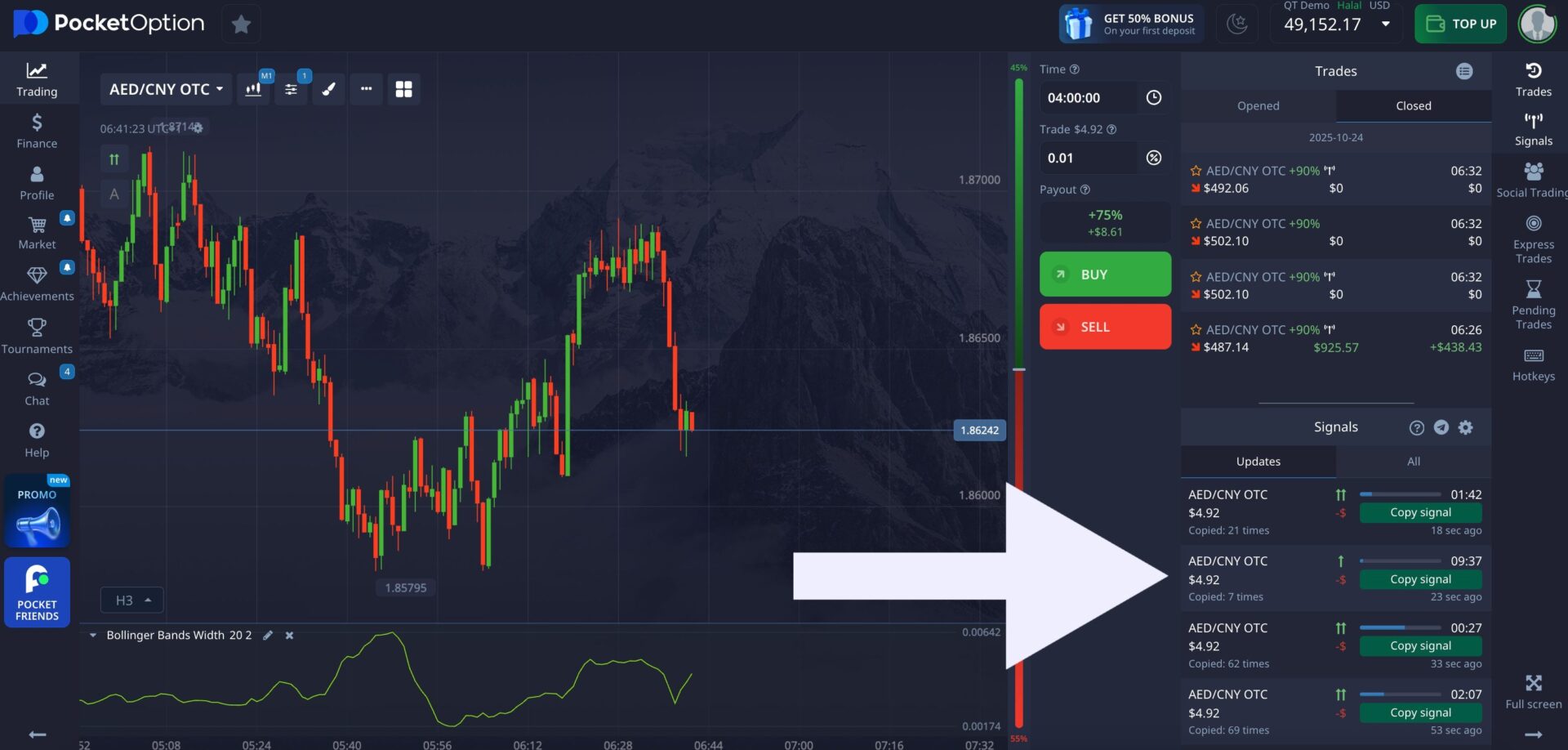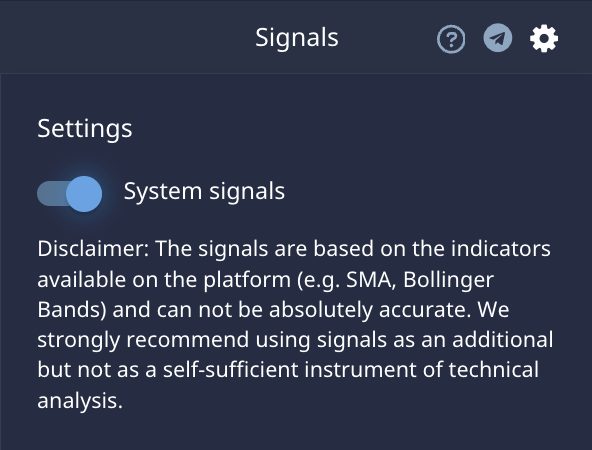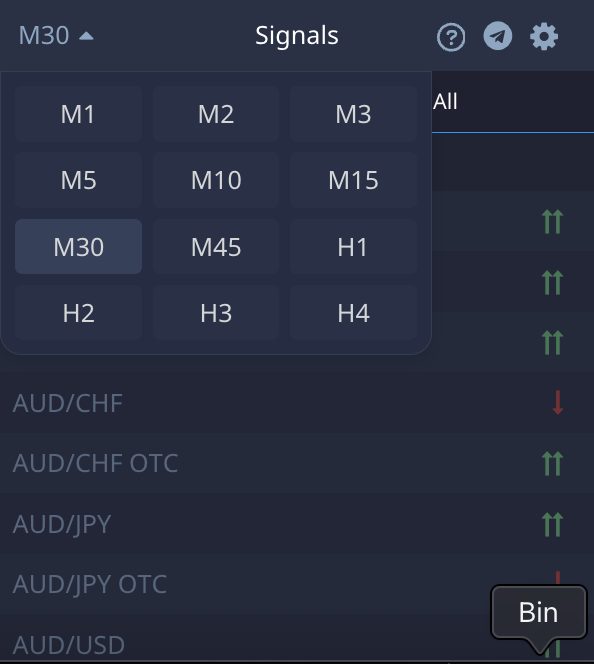Pocket Option Signals Review
- Signals Rating: 7.3/10
- Minimum Trade: $1
- Derived From: Technical indicators
- Delivery Method: Built into platform
- Cost: No charge to receive or use signals

Signals at Pocket Option are built-in, algorithm-based suggestions that flag potential trades across various assets, all updated live inside the platform. They appear directly in the trading interface. You can spot them from the side panel marked “Signals.” Each signal includes a green or red direction arrow, an asset name, and a count of how many people have acted on the signal already. Find out what are our testers thought in this Pocket Option signals review.
Headlines
- Pocket Option’s signals get a 7.3/10 with credit for accessibility and breadth across currencies, stocks, indices, cryptos, and commodities; but loses points for transparency behind workings.
- We made 50 trades on major forex pairs and leading cryptos using only Pocket Option’s built-in signals, mainly with 1–5-minute expiries and fixed stakes across normal hours and volatility spikes.
- They work best for traders looking for quick, built-in cues (especially beginners or intermediates who want support) rather than those seeking deep algorithmic insight or custom filters.
- In testing, we weren’t pleased when the market sped up and we noticed some lag or weaker outcomes, which reinforces that binary signals don’t equal automatic success.
- Given that the signals service is included free for account holders, it represents value, provided you’re aware of the risks, maintain discipline, and combine it with a solid strategy and money management.

Signals can be found in the widget on the right
Pros & Cons
Pros
- Fast and convenient access: Signals are built directly into the Pocket Option platform; no need to rely on Telegram groups or third-party apps (although a Telegram service is also provided).
- Low cost: Account holders get full access without deposit thresholds or the premium plans we see at some other providers.
- Broad market coverage: Signals span forex, crypto, indices, and commodities, giving plenty of trade ideas almost every minute.
- Real-time refresh: Signals update instantly as market data shifts, keeping execution timing tight.
- Easy to act on: You can place a trade directly from the signal window without switching screens or menus – it requires just one click – ‘copy signal’.
- Suit short-term traders: The signals give a quick way to scan multiple assets without manually juggling charts, which is a plus if you’re day trading or running short sessions.
Cons
- No transparency on algorithm: The system doesn’t adequately explain how signals are calculated or which indicators carry the most weight – just that e.g. Bollinger Bands are used.
- Inconsistent performance: Accuracy fluctuates depending on market volatility and asset type. In testing, they felt most effective on fast-moving assets like major forex pairs and popular cryptos.
- Limited customization: Traders can’t tweak or filter by confidence levels, strategy type, or indicators used – it’s either replicate the trade or don’t.
- Short-term bias: Most signals are geared toward rapid expiry times, e.g. 1 minute and 10 minutes, making them less suitable for slower-paced traders.
- No integrated performance tracking: There’s no historical record of past signal performance, which makes long-term evaluation tricky.

How Pocket Option signals are calculated
Claims vs Reality
What the platform states:
- Pocket Option notes that “success rates typically range from 55-65% for most users” when using its AI-driven tools.
- On a “Trading Signals” knowledge-base page, they claim signals with an accuracy “typically showing 70-85%” under “properly analyzed” conditions.
- They also claim that their algorithms analyse multiple factors (technical, fundamental, and AI).
What we observed in our testing:
- Over approximately 50 test trades using signals on major forex pairs and cryptos during normal market hours, our achieved win-rate was in the mid-60% range.
- During higher volatility periods (news bursts, crypto spikes), the hit-rate dropped closer to the 50% mark.
- We noticed that expiry time mattered: allowing slightly longer timeframes (e.g., 5 minutes vs 2 minutes) improved hit-rate modestly.
- We found no published large-sample independent back-test (hundreds of trades) publicly verified by Pocket Option. The published 70-85% figure appears more promotional than documented.
Summary
Win-rate claim:
- Platform claim: 70–85% (“when properly analyzed” using standard signals)
- Our test result: 60–65% in stable periods / closer to 50% in volatile periods
- Notes: Real-world ‘ideal conditions’ are hard to sustain
Win-rate (broad) claim:
- Platform claim: 55–65% (“over extended periods” using AI-powered signals)
- Our test result: Roughly aligns with our averages
- Notes: Many users may achieve lower than this
Transparency of stats:
- Platform claim: Low; no extensive public audit of signal history
- Our test result: We did not find independent, verified results
- Notes: Treat reported results cautiously
Consistency over time:
- Platform claim: Implicitly ‘varies by timeframe & asset’
- Our test result: Variation is significant – wins are absolutely not guaranteed
- Notes: Performance appears (as we’d expect) asset- and market-condition dependent
Pocket Option’s signals can add structure and save time, but they shouldn’t be mistaken for a predictive model. The algorithm does a decent job of identifying momentum shifts, but, like any technical tool, it benefits from human oversight.
Range of Assets Covered
Pocket Option’s signals cover a surprisingly broad list of instruments.
During testing, we saw regular alerts across major forex pairs such as EUR/USD and GBP/USD, alongside popular cryptocurrencies like Bitcoin, Ethereum, and Litecoin.
There were also occasional signals for commodities and stock indices, though those appeared less frequently.
This broad coverage makes the tool useful for traders who like to switch between asset classes.
Frequency and Delivery
Signals are delivered directly through the Pocket Option web and mobile-optimized web platform – no need to sign up for Telegram or external apps. That said, Pocket Option does run a dedicated Telegram signals service.
On average, during busy market hours, we received around one to two new signals per minute across all instruments. That pace might sound hectic, but you can easily filter by asset or timeframe (M1 to H4) to focus only on what you trade.

The timeframe can be adjusted in the top left of the signals panel
Compared with third-party binary signal providers that rely on delayed messages or emails, Pocket Option’s in-platform delivery feels faster and more synchronized with the market. It also reduces the distraction of toggling between multiple screens or channels.
We’d like to see more detail behind each signal, like a quick note on which indicators triggered it or a visual cue on the chart itself. Still, the built-in approach keeps things simple and avoids the clutter you often get from external feeds.
Managing Risk
It’s easy to get caught up in the excitement of quick alerts, but Pocket Option’s signals service, and any binary signals, work best when paired with proper risk management.
Since the signals don’t come with built-in stop-loss or take-profit functions (as they would on a traditional forex platform), it’s on you to manage exposure and timing.
During testing, we found that setting a fixed trade amount per position, rather than scaling up after each win, helped smooth results over time. It’s tempting to chase every green arrow, but consistency beats reaction speed in the long run.
Pocket Option’s platform does include some helpful features to stay in control. You can cap your daily trade volume, track your balance progression in real time, and switch to a demo account instantly if things go off track.
That flexibility makes it easier to pause, reset, and recalibrate your approach without financial stress.
Practical Tips From Testing
Here are a few lessons we learned first-hand when using Pocket Option’s signals:
- Avoid trading during news spikes; the algorithm tends to misfire when volatility goes off the charts.
- Stick to liquid assets like EUR/USD or BTC/USD, where returns and liquidity tend to be higher.
- Consider extending your expiry time slightly beyond the signal’s suggested window to give trades more breathing room.
Combine signals with a simple indicator like Moving Average Convergence Divergence or Relative Strength Index for confirmation.
Used this way, Pocket Option’s signals become more of a useful support tool rather than a shortcut. They can help you spot setups faster, but the real edge still comes from disciplined execution and controlled risk.
Bottom Line
Pocket Option’s signals do offer a meaningful addition compared to random guessing (if used under favorable conditions), but they are not a guarantee.
A win-rate in the 60% range (with good risk control) could produce a positive outcome, but you’ll still encounter losing streaks.
Because the performance drops in volatile periods or fast-moving markets, you’ll need to apply good trade timing and avoid reckless sizing.
The lack of transparent, large-sample verified data means you should run your own trials (preferably in a demo environment) before scaling up.
Treat the signals as a starting point, along with your own filters (asset selection, expiry, risk sizing), rather than a “set-and-forget” system.
Read our general Pocket Option review.
This review is for informational/educational purposes only and is not financial advice. Binary options are high-risk and you can lose all invested capital. Our assessment reflects testing of Pocket Option’s built-in signals over around 50 demo trades on major FX pairs and popular crypto during normal market hours, plus spot checks in higher-volatility windows. The sample size is limited and results will vary by asset, timing, payout, and market conditions. Demo results may differ from live results; do not assume the same win rate is achievable on a live account.
Article Sources
Professional Trading Solutions With Pocket Option Signals
Pocket Option AI Trading Success Rate Analysis For Informed Traders